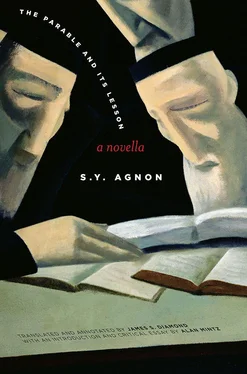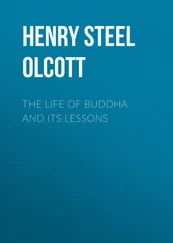The effort at containment is palpable in the shamash’s account of Aaron’s fate. The shamash first tells us about the student’s religious crisis in Chapter 2, at the point when his disappearance is first discovered, and then again in greater length in Chapter 7, when he is encountered in Gehinnom. In both instances, the affecting and disturbing tale is thickly overlaid with the shamash’s stern moralizing. Only when the rabbi and the shamash first come across Aaron’s shade is the young man allowed to speak in his own voice. In its mixture of pathos and fatefulness, it is a moment that seems taken directly from Dante’s Inferno .
At this Aaron let out a wail and began crying loudly and bitterly. “They never let me! They never let me go to her! They buried me in their cemetery, a Gentile cemetery with a cross on my grave!… They cut me off from Jews, and I couldn’t even go into a Jewish home. When I wanted to leave my grave to visit my wife in a dream and tell her that I was dead and that she was free to remarry, the cross would bar my way, and I could not get to her. Rebbe, Gehinnom is terrible, but the torment of knowing that I left my wife to be an agunah is much, much worse.” (22)
Aaron’s remorse comes too late; his responsibility for a grievous wrong cannot be evaded. At the same time, however, he never meant to injure Zlateh, and his own plight is terrible and visited on him for eternity. Yet the shamash is quick to intervene and prevent Aaron from continuing to tell his story in his own words. He explains to his listeners that he will now proceed to narrate Aaron’s story in the third person, assuring them that none of the substance of the situation will be lost in converting from one mode to the other (22–23). He further assures the listeners that the shift is merely a technical matter necessitated by the fact he could not retrieve the young man’s exact words because of the profound mortification he (the shamash) was experiencing when he heard them.
The shamash’s quick appropriation of Aaron’s voice answers another need as well. It shuts down the source of pathos that radiates from the young man’s situation. Left to tell his own story in his own words, Aaron would reprise and amplify the soul-rending theological emergency that impelled him to take the heedless steps that delivered him to his present fate. The shamash therefore initiates deliberate measures to take over Aaron’s story and reframe it in such a way as to minimize the effects of the corrosive doubt consuming the life of the young scholar. He does so by making Aaron’s fate into a moral exemplum for the dangers of intellectual inquiry ( ḥaqirah ), which, rather than leading to true knowledge, places the seeker deeper and deeper into the clutches of the qelipot (literally, husks), seductive demonic forces that imperil the soul of the believer. This theological schema makes the shamash very much of his time and place and reflects the penetration of Lurianic Kabbalah into the scholarly circles of Polish Jewry, especially through the writings of Rabbi Isaiah Horowitz (c. 1565–1630), the author of the Shenei luḥot habrit , which itself was first published in 1648. Aaron is portrayed as a rationalist whose desperate search for reasons for God’s apparent abandonment of His people, for which he learns Latin and immerses himself in “alien” wisdom, leads him down a slippery slope to apostasy and death. In that portrayal, the harrowing pathos of Aaron’s individual fate, in all its troubling implications, is exchanged for a pitiable case study in a transgression against norms held jointly by the shamash and his pious listeners.
It is worth pausing for a moment to consider how unlikely it would be to find Aaron’s story, even as filtered by the shamash, in any text from the period in which our story is set. The explicit wrestling with the problem of theodicy provoked by national catastrophe has a distinctly modern tang to it, as do other features of the story, especially its consciousness of its multiple narrative planes. Indeed, in the final pages of the story, the narrator — that is, the overarching narrator who allows the shamash to recount many of the events — makes direct reference to the Holocaust, in which the communal register recording these events was destroyed. In fact, throughout ‘Ir umelo’ah 20references to the murder of European Jewry are common, although the events of that period are not represented. This means that Agnon’s narrator, in this story as in others, writes about earlier times out of an awareness of what has taken place in his own; and in a profound sense his very motive for telling these stories is fueled by that catastrophic loss. It is therefore not farfetched to say that at some level 1648 is viewed through 1939–1945, and vice versa. 1648 is presented as a kind of rehearsal for the Holocaust, while at the same time the sort of theological crisis Aaron suffers is retrojected from the modern period to seventeenth-century Galicia. The parallel can be taken even further. The Khmelnitski massacres, even though causing vast collective devastation, did not bring about the horrible totality of the Final Solution. Buczacz survived, albeit in the traumatized state described in our story, and with time Galician Jewry rebuilt its communities and institutions and flourished. Now, this would seem to be where the parallel breaks down, were it not for the fact that there is an offshoot of European Jewry that not only survived but flourished: the Yishuv and the state of Israel. And so there emerges a different kind of parallel, one between Buczacz and Israel. The whole of ‘Ir umelo’ah can be taken as a project in which one is substituted for the other, although it is never wholly clear at any given moment precisely which for which.
As much as Hamashal vehanimshal is a story that represents the traumatic persistence of 1648, it is also a story that represents the way in which catastrophe can be mourned. This is not mourning as a state of vanquished dejection but rather mourning as a dynamically active liturgical process that both commemorates the dead and tends to the needs of the living. Agnon devotes a substantial portion of the story to the observance of the twentieth of Sivan; he positions these scenes, especially the rabbi’s parables (as in the title of the story), so as to serve as the climax of the narrative, and he makes them thick with quotations from Scripture and the sacred poetry composed to lament the recent disasters. Whether or not the rabbi’s parables serve their climactic purpose is a question that will be taken up in a subsequent section. The focus here is on the ceremony of mourning.
Like the ninth of Av, the twentieth of Sivan (a date in the Hebrew calendar that falls in the late spring) is a date to which many calamities have been attached. Its origins perhaps lie in massacres surrounding a blood libel in Blois in 1171 and the day decreed by the Tosafist Rabeinu Tam for its commemoration. Five centuries later, when the Jews of Nemirov were murdered by Cossack bands in the late spring of 1648, the date was taken up in the aftermath as a day of fasting and mourning for all the victims of the massacres, much as in our own time the Warsaw Ghetto Uprising (April 19, twenty-seventh of Nissan) came to stand for the Holocaust as a whole. In the economy of its narrative, Hamashal vehanimshal turns away at this point from a preoccupation with the journey to Gehinnom and its aftermath and clears a monumental space for a depiction of the observance of the twentieth of Sivan. Even though the Jewish population of Buczacz is not large — it will become so in the following century — the depiction is monumental in the way it is framed. It is presented as a phenomenon of what might be called liturgical totalization. Every last member of the community, even nursing mothers with their infants, fasts and makes the trip to the cemetery and later stands for hours in the synagogue for the intoning of dirges and the rabbi’s eulogy for the dead. There is an intimate, reciprocal relationship between the living and the dead: “Some went to visit their relatives’ graves, some to entreat the dead to pray for the living” (39). Even though Buczacz physically escaped the massacres, it has subsequently been turned into a kind of necropolis. The cemetery itself is so overloaded with graves of martyrs that the Rabbi has relocated the venue of the eulogy to the synagogue, lest in the jostling kohanim, Jews of priestly origin, be inadvertently pushed into stepping on burial plots, where they are forbidden to go. For the Rabbi, the omnipresence of the dead is a nightmarish perception rather than an actuality. In explaining the transfer of the ceremony from the cemetery to the synagogue, he says, “Why do I need to go to the dead when they are coming toward me?” (40). The Rabbi’s meaning, according to the shamash, is that the town proper contains so many unknown graves of murdered Jews that it may be forbidden for kohanim to reside there altogether. The fact that the Rabbi has not issued a definitive ruling is found curious ( qetsat qasheh ) in the eyes of the shamash, given the Rabbi’s usual diligence in getting to the bottom of any legal issue he addresses. We, however, are given to understand that the matter is ultimately not a legal one but the projection of a consciousness enmeshed in the world of the dead.
Читать дальше












![Edward Ellis - Adrift on the Pacific - A Boys [sic] Story of the Sea and its Perils](/books/753342/edward-ellis-adrift-on-the-pacific-a-boys-sic-s-thumb.webp)